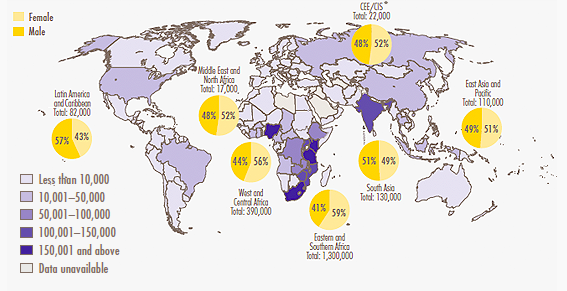The AIDS-Fighting Tampon – The Atlantic
You might have heard that AIDS is not as deadly in Africa as it once was. Deaths from the disease have declined by a third in sub-Saharan Africa since 2005.
But the virus is actually becoming more prevalent among adolescents—particularly adolescent girls. In many African nations, teen girls are two or three times more likely to contract HIV than boys are, according to UNICEF.
Gender Distribution of HIV Among Teens, by Region
 Estimated number of adolescents living with HIV and percentage female, by region. (UNICEF)
Estimated number of adolescents living with HIV and percentage female, by region. (UNICEF)
One reason is that girls in some African nations are pressured into early sexual debut and early marriage. That, combined with low rates of condom use and the possibility of multiple sex partners, increases their potential for HIV exposure over time.
And it’s not just a problem facing African women: In the U.S., 84 percent of women diagnosed with HIV get it through heterosexual sex.
There are already a few options available for women who want to prevent HIV infection. Daily pills called called pre-exposure prophylaxis, or PrEP, are prescribed for some people who are considered high-risk, and there are always condoms or female condoms—though many women find it hard to convince their partners to use them.
Women can also use microbicide gels just before sex, but these gels are messy and hard to use. They have to be applied up to 15 minutes before sex and in large quantities.
That’s why there’s hope for an innovative technology designed by researchers at the University of Washington in Seattle: An HIV-preventing tampon. The contraption is made up of an electrically charged polymer fabric with threads that are each about 200 times smaller than a human hair. The material is interwoven with HIV-fighting microbicides, which are dispersed as the tampon dissolves within six minutes of insertion.
The short dissolving time is key, says Cameron Ball, a doctoral student in bioengineering with the University of Washington: “That means women don’t have to apply it far in advance of having sex,” he told NPR. “There’s a race between the anti-HIV microbicide to get to the tissue before the virus does.”
Ball told NPR that the ultimate goal is to combine the microbicide with a contraceptive spermicide that would protect against pregnancy in addition to HIV. If the researchers’ tests on monkeys and rabbits prove successful, the fabric should be available in about 10 years.
Down the line, the special fabric could also be packaged in the form of a vaginal ring or some other mechanism—the tampon is just one possibility.
“It’s a matter of giving women enough choices and options of what products are available and how they are used,” Ball said.
http://www.theatlantic.com/health/archive/2014/12/the-aids-fighting-tampon/383363/



